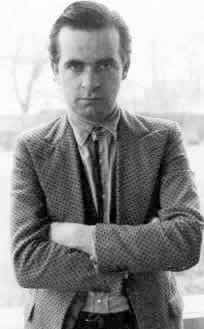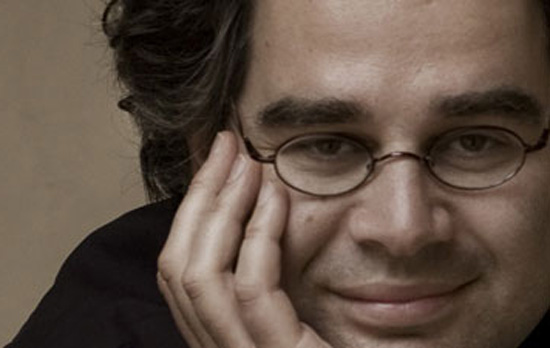Share This
Album at a Glance
Tags
Related Posts
Olivier Greif: Sonate de Requiem; Piano Trio
Posted by Paul Ballyk on Aug 8, 2013 in Contemporary | 1 comment
Originally released in 2006, Harmonia Mundi has returned this recording of Olivier Greif's Sonate de Requiem and Piano Trio to the active catalog as part of their mid-priced HM Gold line. Not having heard the initial release, I feel fortunate that I didn't miss this powerful and moving music again, this time around. The performances by cellist Emmanuelle Bertrand, pianist Pascal Amoyel and violinist Antje Weithaas garnered high praise for the original issue.
Admitted to the Paris Conservatoire when he was ten years old, Olivier Greif (1950-2000) was an exceptionally gifted child. He was a composer with a highly individual style who followed his own path, seemingly unconcerned with the musical trends of the day. His numbered works exceed 360. A large portion of these are for solo piano and most of the rest would be classified as chamber music, including the two works on this CD.
The Sonate de Requiem Op. 283 for cello and piano was written in 1979, following the passing of the composer's mother. It is a reflection on death from three meditative viewpoints: loss of a loved one, the 'journey' of the spirit's ascent, and a contemplation on the coming together of one's soul with its Source. The piece delivers a listening experience far beyond what you might expect from the modest pairing of cello and piano. Greif accomplishes this by frequently requiring each instrumentalist to take on two or more completely different musical roles. For example, the piano might carry an airy delicate line in the upper register of the keyboard, while adding at intervals explosive tone clusters in the low register. With the cello also taking on multiple musical personalities, a density and diversity of sound is produced which suggests there is much more at play than only the two instruments.
The music is difficult to categorize. It's tonal, but freely so - not much different from what you might expect from Bartók or Shostakovich. Darkly colored, it favors minor modes. Sometimes it's modal, evocative of Far Eastern tonalities for instance. Greif makes frequent use of various techniques to produce striking gestures in sound (such as the previously mentioned explosive tone clusters). You can hear examples of this in both of the samples I've provided. The video in the right sidebar is the final Alla breve movement of the Piano Trio and the bonus video below is the opening movement of the Sonate de Requiem.
Very little of Greif's music has been recorded. I hope that the reintroduction of this Harmonia Mundi disc will spark interest in listeners to hear more, and a desire in record companies to record more of his music.
"I have never composed so much in my life. If I ask myself the reasons for such a profusion, I realise that it is because I have nothing else in my life but music. If I stop composing, I die," Olivier Greif wrote after finishing his Trio in 1998. This CD presents two deeply moving works by a true citizen of the world, indifferent to the aesthetic confrontations that marked the half-century of his life. 1950 - 2000: between these two dates lay "a convoluted path through shadows and light, where hope and despair are intertwined like two lianas issuing from a single stump" (Brigitte Francois-Sappey).
Source: Harmonia Mundi
|
Olivier Greif, composer Olivier Greif was born in Paris on January 3rd, 1950. His father had studied piano in Poland before moving to France and becoming a doctor. A precocious child, Olivier discovered music at age three in a kindergarten. Admitted to the Paris National Conservatory at age ten, he studied piano with Lucette Descaves and composition with Tony Aubin. |
|
|
Emmanuelle Bertrand, cello Discovered by a wide public when she won the young soloist category at the Victoires de la Musique Classique in 2002, Emmanuelle Bertrand is one of the leading representatives of French cello. She was a pupil of Jean Deplace and Philippe Muller at the Conservatoires Nationaux Supérieurs de Musique of Lyon and Paris and went on to be a prizewinner in the 1994 Rostropovich International Competition in Paris. |
|
|
Pascal Amoyel, piano Voted “Solo Instrumental Discovery of the Year” at the Victoires de la Musique in 2005, Pascal Amoyel has established himself over the past few years as a significant personality on the musical scene. As a teenager he was profoundly influenced by his encounter with György Cziffra, with whom he studied in France and Hungary for several years. |
|
|
Antje Weihaas, violin One can hardly imagine a better advocate for music than Antje Weithaas. For her, not only does music itself take the fore but also its conveyance to the public. As one of the most sought-after soloists and chamber musicians of her generation, Antje Weithaas has been invited to perform with Germany’s leading orchestras, including the Deutsches Symphonie-Orchester Berlin, Bamberger Symphoniker, and the major German radio orchestras, as well as numerous major international orchestras. |
| Thinking about purchasing this album?
Follow this link for more album details or to make the purchase. Buy it now |
“Not just recommended. Guaranteed.”
We stand behind every album featured on Expedition Audio. Our objective is to take the monetary risk out of music exploration. If you order this album from HBDirect.com and do not like it you can return it for a refund.
The opening movement of the Sonate de Requiem by Olivier Greif









Beautiful music and presentation